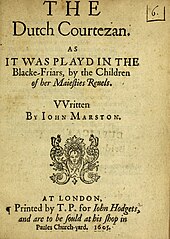The Dutch Courtesan

The Dutch Courtesan is an early
Printing and performance history
The play was entered into the Stationers' Register on 26 June 1605, and published later that year by the bookseller John Hodgets, printed by Thomas Purfoot. The play was revived in the following decade, and performed at Court by the Lady Elizabeth's Men on 25 February 1613.
The Dutch Courtesan was a popular work at the time, and was performed and adapted several times during the
Plot and themes
Freevill is deeply involved with the "Dutch Courtesan" Franceschina but he is about to marry Beatrice, daughter of Sir Hubert Subboys and decides to break with Franceschina. He introduces her to his friend Malheureux who at once desires her. Humiliated, she promises to submit to him if he kills Freevill and bring her a ring he has received from Beatrice. The two friends pretend to quarrel, Freevill vanishes, the ring is brought to Franceschina. She goes off to inform Freevill's father and Beatrice's father of what has happened. Malheureux is arrested and condemned to die. At the last moment, Freevill appears and explains he has done this to cure Malheureux of his passion. Franceschina is whipped and imprisoned.
The play explores the nature of human desire and the problems involved with trying to lead a "good," moral life when sexuality is a fundamental part of human nature. Critics have judged the play both anti-
Sources
It is now generally agreed that the principal source of main plot of The Dutch Courtezan was a story drawn from the first book of Les bergeries de Julliette by Nicolas de Montreulx, published in 1585.[2] But in its moral framework the play, like much of Marston's work, is also deeply indebted to the Essays of Montaigne, especially to the essay Sur des verses de Vergil (On some verses of Vergil) (III.5), which discusses the control of physical desire and the difference between love and lust.[3]
Background
London society of the 1600s already had a
Notes
References
- Caputi, Anthony. John Marston, Satirist. Ithaca, NY, Cornell University Press, 1961.
- Chambers, E. K.The Elizabethan Stage. 4 Volumes, Oxford, Clarendon Press, 1923.
- Cross, Gustav. "Marston, Montaigne, and Morality: The Dutch Courtezan Reconsidered". ELH 27 (1960), pp. 30–43.
- Finkelpearl, Philip J. John Marston of the Middle Temple. Cambridge, MA, Harvard University Press, 1969.
- Higgins, Siobhán. Britain’s Bourse: cultural and literary exchanges between England and the Low Countries in the early modern era (c. 1580–1620). PhD Thesis, University College Cork, 2017.
- Logan, Terence P., and Denzell S. Smith, eds. The New Intellectuals: A Survey and Bibliography of Recent Studies in English Renaissance Drama. Lincoln, NE, University of Nebraska Press, 1977.
- O'Connor, John J. "The Chief Source of Marston's 'Dutch Courtezan'". Studies in Philology 54 (1957), pp. 509–515.
- Wine, M. L., ed. John Marston: The Dutch Courtezan. Lincoln, NE: University of Nebraska Press, 1965.
External links
- First edition by John Hodgets (1605) (Internet Archive)
- The Dutch Courtesan Project: essays and filmed production (University of York)
